Why don’t more apparel decorators “Go Green”? …and by “Go Green”, I don’t mean the color of the shirt, thread, or ink. This isn’t a St. Paddy’s day stunt either.
We live in some interesting times. Besides the constant product disruption in business, our capitalistic efforts in the last century have put a growing burden on our planet. In the past few years many corporations have focused their efforts in becoming more environmentally friendly. Having a strong triple bottom line pays off with shareholders these days. (social, environmental & financial)
Just plop into any corporate webpage and check out their blog posts, annual reports or sustainability mission statements. You can see that they are making some valiant efforts in reducing their environmental risk, while building a healthier bottom line. Not to mention using a sustainable mindset when developing new products for their customers. Click the links and check these out:
So if the big boys are interested in this, why doesn’t it trickle down into the smaller company world? (Meaning – your company to be exact.) Are people less concerned about the planet? Are companies less interested in making more money?
Is there any direction for a “sustainable future” for apparel decorators?
I think there is. However, when I speak to shops about this topic most people either don’t know where to start, or think it is just the domain of larger companies. “We are too small to make a difference”, they say.
Most companies in our industry segment comprise of firms with less than two hundred people, and under $10 million in sales per year. In fact, if you attend any trade shows, or discuss customers with the supply chain folks you’ll find that most shops are about twenty or thirty people and about $1 million or less in sales. Their biggest headaches are all about growth, being eaten alive by the online commerce world, personnel challenges, and for some…just making payroll.
Going green sounds nice, but who needs that extra work? What’s the payoff anyway? For a lot of shops just doing anything beyond recycling their soda cans seems like a pipe dream.
Let’s Change That
The benefit of any long term, serious and organized effort with sustainability is always more efficiency (getting more work completed with easier methods), bigger financial rewards (more money at the end of the year), and a competitive advantage (better customers).
Let’s break these down one by one:
More Efficiency
Sustainability is focused on doing more with less. In the decorated apparel industry what does this actually mean? More shirts embroidered or printed for less operating costs. More orders completed per day. Less downtime. Better trained staff, using superior tools, producing higher quality work.
That equates to a stronger, more profitable business for you and happier customers in the end.
Picture in your mind your shop floor. Imagine all the processes needed to produce an order. Let’s say that a process in a department takes five steps to complete. If you can figure out how to complete the same process with three steps, then that’s more efficient. If you remove a consumable, or use less of it, during the process then it becomes cheaper. If you can handle the same workload, but complete it faster then your efficiency pushes the operating costs even lower.
Less = More
Regardless of the size of your shop, this holds true. However, most smaller shops are reluctant to start a sustainability program as it seems too daunting, with too little payoff.
The trick is to just get started, and review every step in your business and just simply ask “is there a better way”? Often, there is a different technique, product, machine, training, method or even employee that can push the limit on the current status quo. You just have to be comfortable in getting out of your own way and asking “why do we do it this way?”
Why indeed?
For example, let’s look at the new battle that’s going on with film vs computer to screen systems for screen-printing. I realize these machines are expensive and possibly out of reach for some smaller manual shops…but it is a good topic to review for illustration purposes. If you are a printer that burns over fifty screens a day, you should seriously consider this equipment, from an efficiency and sustainability point of view.
With film, each separation plate is laboriously printed either on a per sheet or on a roll basis. The cost just for the film alone is about a dollar a plate on average. How many screens do you go through a day? For the sake of argument, let’s say you burn that fifty. At a dollar each, that’s $250 a week. That equals $13,000 a year. Let’s say you add in the labor for the screen room tech to handle and file the films and use them to make the screens with ten minutes per screen at $10 an hour, that’s $1.70 per screen, which equals $85 for the day, $425 for the week, and $22,100 for the year.
$13,000 + $22,100 = $35,100. That’s a rough guesstimate at what your screen room costs for using film could be. (You should already know your real cost, but if not simply measure yours to get the exact total: consumables + labor)
If you haven’t been to a trade show or read one of the industry magazines lately, the M&R STE II Computer to Screen system can image and expose a screen in under a minute. Using LED technology, it is making a tremendous impact on screen rooms all over the world for efficiency. There are other brands and they are all great too, but none matches this speed and quality. It’s groundbreaking. Watch their video of one person coating, imaging, exposing, and rinsing 400 screens in one eight hour shift – Click Here.
Using CTS, you eliminate the need for films forever. For our example, that’s $13,000 a year off the top. For easier math, let’s use 1 minute per screen as our average here, at the same labor rate of $10 per hour. $0.20 per screen x 50 = $10. For the week, that’s $50. Yearly that’s $2,600 for labor.
So if you eliminate the film by going digital, that’s a $13,000 a year on consumable savings, at fifty screens a day. There is a $19,500 a year labor savings. Added together that’s $32,500. Per year. Which makes the ROI on this about two years. Then, that money goes to the bottom line forever.
Also, let’s mention that when using a CTS system you can keep a small halftone down to about a 4%-5% range, eliminate moiré completely, avoid that vacuum table step, and set up faster on your presses as each screen is perfectly registered to any others for the design. With a set up jig like Tri-Loc, you just drop them in and go.
What is your shop production downtime savings worth? You can add that to the pile of money described above.
This is the cost savings efficiency that sustainable-minded businesses are thinking about when they start their programs and continuously improve them. Will this be right for your shop? I don’t know…you’ll have to do the math. The example above is just in general terms. And yes, I know that your screen room tech isn’t just going to be working fifty minutes a day with a CTS system…but imagine all the other things they could be doing. Where could you redeploy that labor and help some other part of the shop? Think of all the other things that guy could be doing.
Bigger Financial Rewards
So what if you adopted this mindset and pushed it into everything you do? Sustainability isn’t about just worrying about using an organic cotton blank, but about truly thinking about efficiency and performance.
Companies that comprehend this are experimenting with anything they come across to find out if it might make sense for them.
For example, take a look at a simple product such as masking tape and how it is used in the shop. How and why are you using it? Have you ever tried a different brand? Is one brand easier to apply or take off than another? Do you even need it in the first place? What if someone marketed a tape that would dissolve in the reclaiming process, would you buy that instead? Then, think of the labor your shop could save if you didn’t have to tape screens at all. There are products on the market now that do that.
Once you start on this journey what you will find is that there is an endless series of questions, that all spawn more questions. As you are pinballing your way through the discovery for the answers, you’ll unearth some very interesting things about your core operational processes.
Usually “the way we’ve always did it” doesn’t perform as well as “the way it should be done now”.
Want to use a better performing press wash, ink system, thread, equipment, software or other tangible product? Your supply chain wants you to know that these items are for sale right now. When was the last time you investigated anything? I talk to so many shop owners and managers that think that changing anything in their shop won’t make a difference. They carry a big disbelief about supplier claims. I get it. However, you do have the power in your own hands.
Scientifically prove that it is worth it by conducting your own trials. Most suppliers can give you samples for free. Benchmark your current state and constantly compare against the new results. Throw the data on a spreadsheet and graph the results over time if you start using something new.
When costs start dropping and the graph looks like a sinkhole opened up as the line plunges to the bottom of the chart, you’ll soon realize why all the big companies are so interested in sustainability. It just makes dollars and sense.
Blacken your bottom line not by raising prices on your customers, but by saving money with the tasks you are already doing.
Competitive Advantage
Here’s where the rubber meets the road. Any shop can recycle their soda cans, or switch out their lighting to LED’s or T8’s. You can build a program, and just slouch your way through it and say you are “Green”. Everyone loves a marketing buzzword. However printing with waterbase inks doesn’t make you green. Neither does just using a recycled or organic blank.
The strongest printing companies will keep going on their journey and become certified sustainable printers. The ultimate printing certification is through the Sustainable Green Printing Partnership, or SGP. Shops that get this certification have to prove that they are doing everything right. Getting the SGP Certification means you aren’t greenwashing. It proves you are an expert, and you are seriously committed to your sustainability journey. Getting certified equates to graduating from college. You’ve earned the pedigree by doing the work and proving you know your stuff.
It also gives you a tremendous marketing tool and an advantage over your competition.
In your marketplace, go to your customer’s websites and also to your main competition’s. Do they have a sustainability section? Go to your “dream” customers websites too…you know that one company that you wish that did business with you. Check to see if they have their sustainability position posted as well. If they are touting their interest in this area, don’t you think that getting the SGP Certification will align with their corporate interests? It’s like dating someone and realizing you both like pistachio ice cream and horror movies. Bingo! It’s love at first sight.
On a job quoting level, if all things are equal with your competition, but you have the SGP Certification and they don’t, who do you think they are going to want to partner with for a long term relationship? SGP wins hands down every time. Because it is proven leverage and a marketplace differentiator. It demonstrates professionalism and corporate responsibility. It is the mark of a leader.
Remember “green” is a color. Sustainability is a direction. It’s action. It’s a money-maker.
Getting Started
Here’s the easy part. If you want to get going with this, it really doesn’t take a tremendous amount of effort or any secret training. I always advise just getting some key members of your staff together for an hour and discuss the idea. On a whiteboard, write down all the easy ways your company can do better on the sustainability front. Score wins with easy victories.
Some examples could be with using energy, such as paying closer attention to the thermostat, installing LED lighting, switching out older appliances for newer energy efficient ones, or even installing motion sensors in common areas like break rooms, bathrooms or supply areas. Even not just turning on your flash units on press until you need them can save money. A lot of shop staff members do things from habit, not by need.
You could start a recycling program, and segregate your materials for pick up. Less items in the dumpster means less pick-ups per week or month. Some materials that are recyclable can generate money back to you, so that’s a benefit as well.
Also look at your preventative maintenance schedule (uh, you have one, right?) and make sure your equipment is well cared for. Lots of shops postpone this stuff as they are “too busy”. However, that hissing noise you are always hearing at your press from the air cylinder leaks is costing you $600 a year in electricity on your air compressor to keep the pressure constant. It’s even worse when there are multiple leaks.
Sustainability is also about doing things more efficiently. The products you use in your shop are a good target for research. Trying to use a better performing ink, maybe a different emulsion EOM, or screen mesh choice so you don’t have to double stroke for opacity is being sustainable. It’s a results driven, performance focused activity. Look at the top ten most commonly purchased items in your shop and see if there is a better item available.
The Cost Objection
One mindset that always comes up is price. Usually better performing anything costs a little more. Most of the time it’s worth it. If you are using the cheapest thread on the market for embroidery for example, and are plagued with constant thread breaks are you really saving any money? What if you switched to a more expensive, but better made and stronger thread? How many more runs per day could you get out of your machines? Don’t let your accounting team control your production decisions.
Performance equals Efficiency which also equals Sustainability. It’s a golden circle, not green. That’s what saves you the moola…
For long term success, build the sustainability idea into your staff’s job functions. After all, performance and saving money should be part of their job descriptions anyway.
If you need help with your program, SGIA has a wonderful work group called the Peer to Peer network that aligns a dozen or so shops together at a time for an hour-long webinar every two weeks. They delve into one topic a session, and work towards the solution afterwards as homework. It’s a great way to connect with other shops, and build your sustainability program in a classroom setting. After completion, you are practically ready for your certification audit.
For more information on the SGIA Peer to Peer Network Click Here.
For more information regarding the Sustainable Green Printing Partnership, Click Here.
“The only thing we know about the future, is that it will be different.” – Peter Drucker
“You cannot escape the responsibility of tomorrow by evading it today.” – Abraham Lincoln
“Excellence is the gradual result of always striving to do better.” – Pat Riley
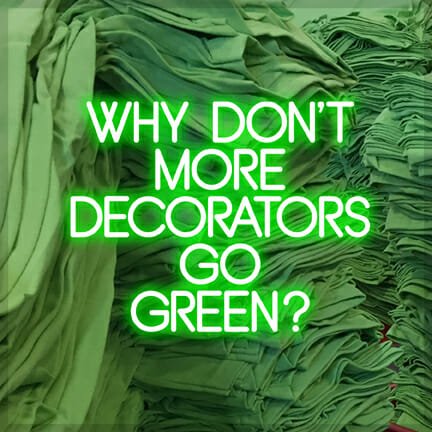
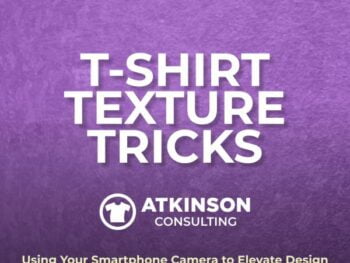
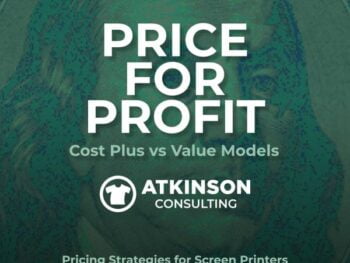
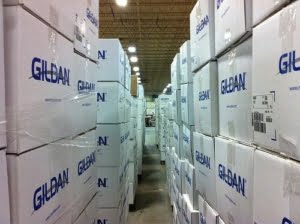
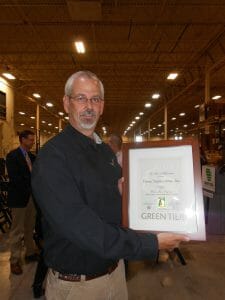
5 comments
Sarah
I’m completely addicted to your blog after finding a few days ago. Can you provide details on the tape which dissolves in reclaiming? My limited googling came up short. Thanks!
sarah
I’m completely addicted to your blog after finding a few days ago. Can you provide details on tape that dissolves in reclaiming? My limited googling came up empty on results.
atkinsontshirt
Sarah: – It’s in development now, but not on the market. Shoot me your e-mail to matkinson4804@gmail.com and when it’s ready I’ll let you know who is marketing the item. Thanks for reading! Please let me know if I can help with any challenge in your business -M
Michael McGloin
We are in a very small town (5000) and our wastewater facility could no longer handle the volume of treated dye wastewater that we were sending down the pipes (when we took on WalMart for around 7 years (we broke up) and we figured out how to treat our dye house/print shop wastewater without chemicals (which has never been done before with color). Our Dye Oxidation System (DOS) purifies our manufacturing process wastewater by removing color and additives without the addition of chemicals. The final, oxygen-enriched product works harmoniously with the microorganisms used in our local city water treatment facility. From June 2013-2016, we’ve been able to reuse over 4,500,000 gallons of water that were purified by our DOS System.
We aren’t a NIKE or any of the other big players, we have around 200 employees (and only had around 100 at that time). If you put your collective mind to it, you can do anything. The system has paid for itself by allowing us to produce more shirts, eliminate the chemicals to treat the wastewater and also the labor it would take to treat the water in the past, has now all been eliminated by this auto system.
atkinsontshirt
Perfect! What a great solution! Thanks for reading and commenting. -M